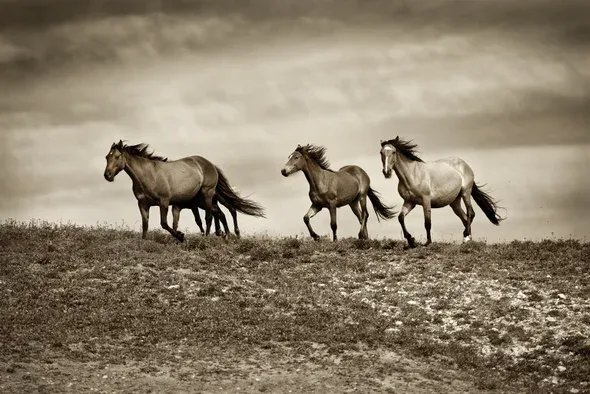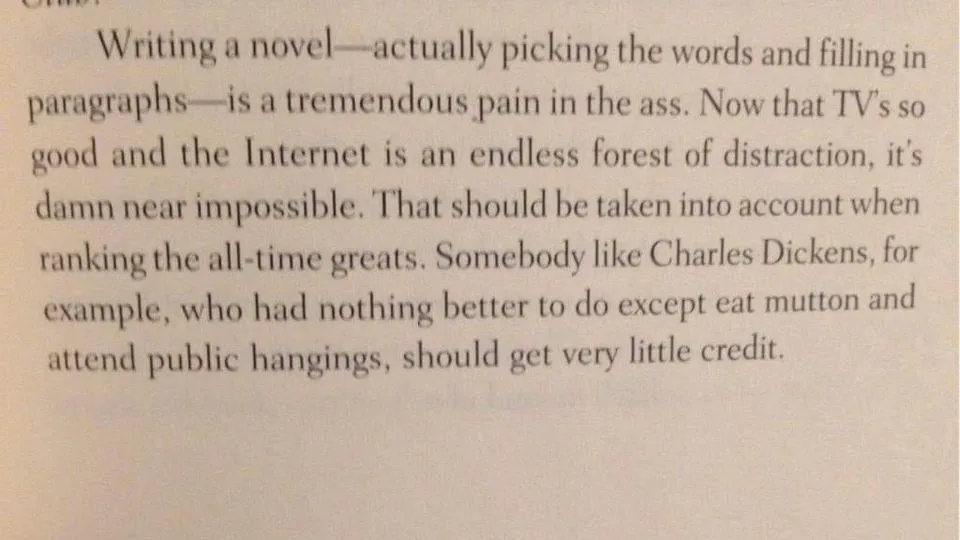
Like most Substack authors, I started with big ideas of what I hoped to accomplish with my newsletter — insightful essays about my favorite topics, a buzzy community of fellow writers and readers, and (maybe) a nice little revenue stream. But probably also like most Substack authors, I didn’t know what the heck I was doing. As I wrote in my very belated introductory post, I struggled with the kind of content I wanted to write. My solution was not to write anything, and for the first nine months my newsletters were nothing more than a bi-weekly-ish curated list of links of stuff that I found interesting around the internet.
I called my sub-Substack “Forest of Distraction,” inspired by the text in the image above,1 and described it as a “weekly miscellany of magical inspiration,” because was intended to inspire creative writing ideas, even as it was a diversion from those same creative ideas.
I really enjoy the Forest of Distraction posts, as it’s just a public extension of my own link-saving habit — I have a huge reference file of random saved articles in my notes app (Evernote and more recently Notion) and it’s fun to pull them out, mix them with newly discovered items, and tie them up with an evocative subject line. I think other people must enjoy them, too, because I’ve never had a flood of unsubscribes after sending one.2 Apparently, the mix history, archaeology, anthropology, geology, art and culture is appealing to others, too, so I was very sorry when I realized recently that it had been over a year since I published an issue!
As I revised my publishing plan to include new editions a bit ore regularly, I took some time to peruse the old posts, enjoying anew the discoveries and wonders of the world. I thought it might be fun to extract some of my favorite items and share them here, kind of a “Best of Forest of Distraction” list. It wasn’t easy! Even though I limited myself to the first 20 issues, I couldn’t whittle the list down to the planned 10 items. So instead, you get twelve: my favorite highlights from the first two years of Forest of Distraction.
If you enjoy this and aren’t already a subscriber to the Magic & Ink Newsletter, be sure to join me there and get all the newest curiosities delivered right to your inbox!
Neolithic Netflix

“A wall relief, comprising five figures carved on a bench in a communal building dating to the ninth millennium BC, was found in south-eastern Turkey in 2021. It constitutes the earliest known depiction of a narrative ‘scene’, and reflects the complex relationship between humans, the natural world and the animal life that surrounded them during the transition to a sedentary lifestyle.” (Antiquity)
Read more: The Sayburç Reliefs: A Narrative Scene from the Neolithic
“In the carving, a six-fingered, squatting human waves what looks like a snake or rattle at a sharp-horned bull in one of the two scenes. ‘It seems to reflect the struggle between two creatures,’ Özdoğa says. In the other scene, two leopards flank a person depicted facing forward, and clutching an erect penis—in what Özdoğa calls ‘an indifferent stance’ in the face of danger. It’s unclear whether the panels are meant to be viewed independently or in sequence, but they convey a shifting attitude toward nature, Özdoğa proposes, as nomadic communities settled down. The struggle with the bull and the indifference toward leopards, respectively, may bookend a story about people learning to subdue wild creatures, the author suggests.”
Read more: Prehistoric Carvings Depict Showdowns Between Humans and Beasts
A Dancing Snow God

“Enter David Riutta—a radio DJ in Hancock and one of the region’s many Finnish-Americans. Translating the name of his favorite country singer Hank Snow into Finnish, Riutta came up with a snow god named “Heikki Lunta,” the subject of his novelty song ‘Heikki Lunta’s Snow Dance.’
“‘Now I’ll sing my song to make the snow come down,’ Riutta sings, as Heikki, in an exaggeratedly deep, booming voice. ‘And I’ll do my dance/Whoops, I almost lost my pants!’ Despite the folksy humor, the song is slow and dirgelike, almost like an incantation. No wonder that, according to local legend, snow fell so voluminously after Riutta played his ‘Snow Dance’ that the snowmobile race had to be canceled, leading him to write and record another song called ‘Heikki Lunta Go Away.’ ‘If I don’t stop [dancing]/Look out–here comes a snowball filled with rocks!’ sings Riutta in his thunderous Heikki voice.”
Read more: The Dancing Snow God That Brings Blizzards to Michigan’s Upper Peninsula
Manufacturing Nature

“They look almost manufactured. Many tortoise beetles have transparent cuticles, the tough but flexible outer covering which gives the insect family its name protects the delicate creature within. The living tissue is often metallic in color and can in some species even change color. The combination is as diverse as it is extraordinary – many look like tiny robots assembled to infiltrate, the ultimate bug. Take a look in at the amazing variations of tortoise beetle our world holds.”
Read more: The Tortoise Beetle – Amazing Metallic Arthropods
Secrets Only Old Swords Know

“‘When I got this sword, it was completely covered in blood rust.’ Sword maker Francis Boyd is showing me yet another weapon pulled from yet another safe in the heavily fortified workshop behind his northern California home.
“‘You can tell it’s blood,’ he says matter-of-factly, ‘because ordinary rust turns the grinding water brown. If it’s blood rust it bleeds, it looks like blood in the water. Even 2,000 years old, it bleeds. And it smells like a steak cooking, like cooked meat. I’ve encountered this before with Japanese swords from World War II. If there’s blood on the sword and you start polishing it, the sword bleeds. It comes with the territory.’
“Blood rust: I hadn’t thought of that. I guess it would turn water red, but the steak comment is kind of creeping me out, as is the growing realization that if these swords could talk, I couldn’t stomach half the tales they’d have to tell.”
Read more: Blood, Sweat, and Steel: My Afternoon with the Ace of Swords
The Gold Lyre of Ur
“The Gold Lyre of Ur was unearthed by archaeologist, Sir Leonard Woolley, in the 1920s during his excavations in the Sumerian city of Ur, in modern day Iraq. Unfortunately, as you can see from the photo at the top of the video, there was little left of the lyre because the Sumerians simply put it into the ground 5000 years ago and covered it over with tons of earth. In the intervening millennia, everything that was degradable turned to dust, and only the imprint of the instrument was left, along with the stone mosaic decorations, the four vignettes made of shell, and the gold. Thanks to very careful measurements and photos taken by Woolley, museum curators have been able to reconstruct the fragile bits and pieces, and the instrument is now on display in Baghdad. What you see in this video is my own replica, made from cedar like the original. Needless to say, I used brass sheeting instead of gold, but it is unlikely that the ornamentation would change the basic sound of the instrument.”
Read more: The Lament for Gilgamesh
Gate of the Gods
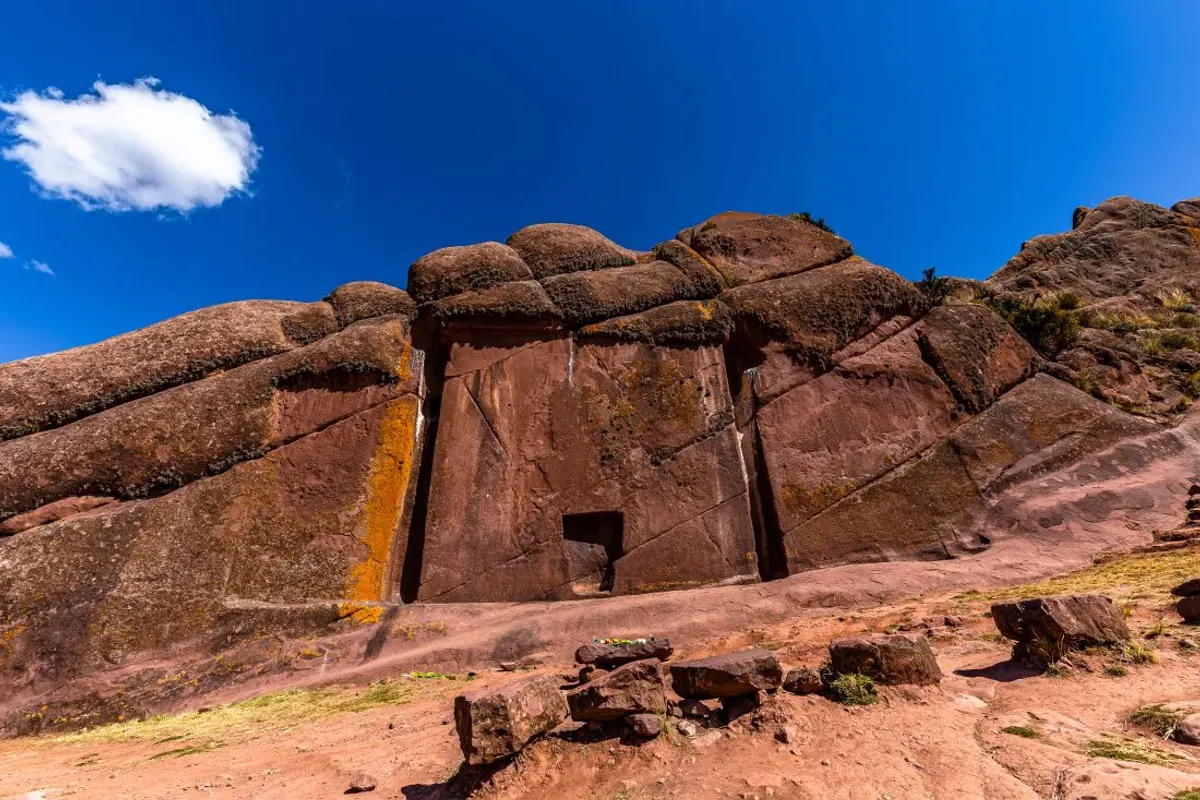
“The mythology commonly points to the doorway being a portal or “star gate”, used to travel to other worlds. Some also believe the door is used by the Gods as a way for them to visit and inspect their kingdoms.
“Despite being widely thought to predate the Inca, Aramu Muru gets its name from an Inca legend.
“It’s said that while evading the Spanish, an Inca priest named Aramu Muru took a golden solar disk known as “the key of the gods of seven rays” that was kept in Koricancha temple in Cusco. Taking it over 450 kilometers (280 miles) from the temple to the stone doorway, the priest placed the disk on the door. Acting as a portal, the doorway allegedly opened, and the priest passed through it and disappeared.
“While believing the legend may offer a source of comfort for some, the story of Aramu Muru also serves as a stark reminder of the desperation felt by a civilization ravaged by, and eventually lost to, invading forces.”
Read More: No One Knows What Peru’s Mysterious “Gate Of The Gods” Was For
Children of the Desert
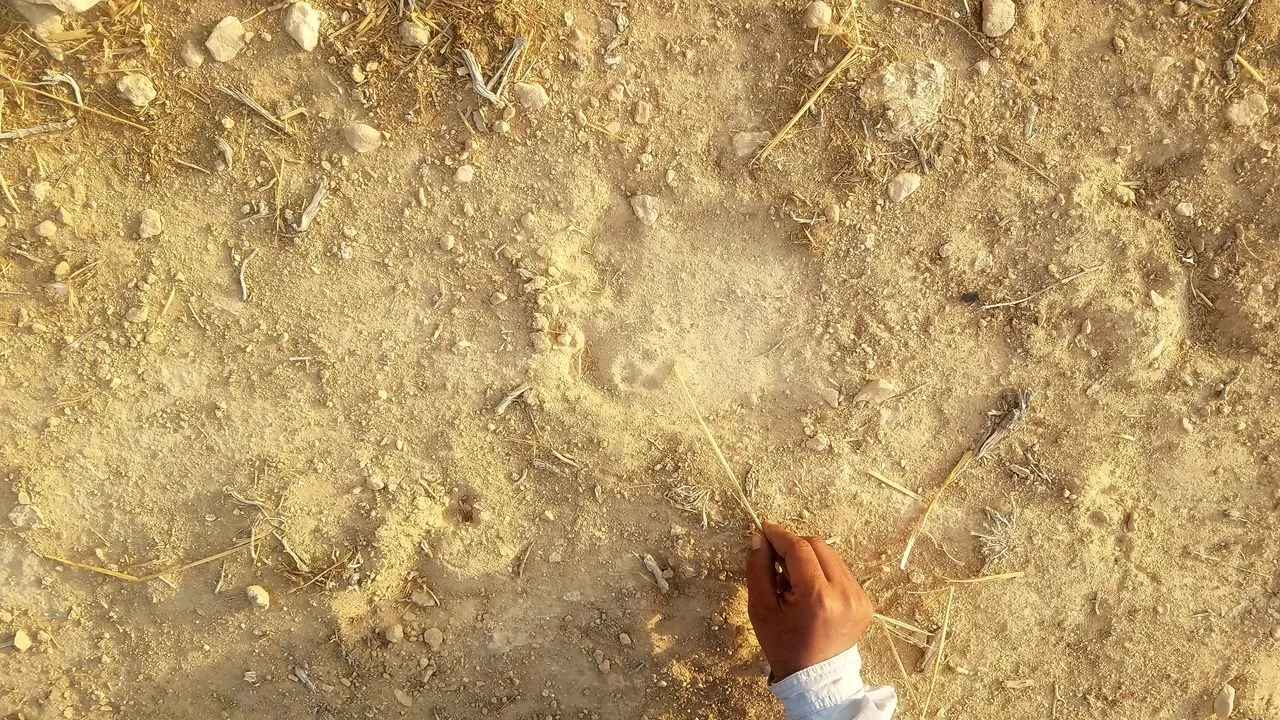
“These subtle signs in the desert contain volumes of information to the properly trained eye. By the depth of the tracks, a tracker can tell whether a camel was carrying anything on its back. They can also tell whether the camel was being led by person or roaming freely. If the camel’s droppings contain corn, rye, or any man-made food, then the camel was not grazing. Also, a camel being led would not graze nearby bushes, and if it did, it would only be along a set route. A roaming camel, on the other hand, skips around from bush to bush with no clear pattern.
“Desert trackers such as Walidie apply this same knowledge to construct a story from a human footprint. This knowledge formed the basis for the cooperation between the Palmach (the Jewish underground army during the British Mandate for Palestine) and the tracker Sheikh Odeh Abu Muamar, before the foundation of Israel. Later the Israeli Defense Forces (IDF) formed a Bedouin Tracker Unit in 1970, which is in charge of finding enemy combatants or drug and arms dealers who cross the into the country. This has blurred the line between the traditional Bedouin practices and modern desert law enforcement.”
Read more: How a Bedouin Tracker Sees the Desert
Like a Map in Front of a Book
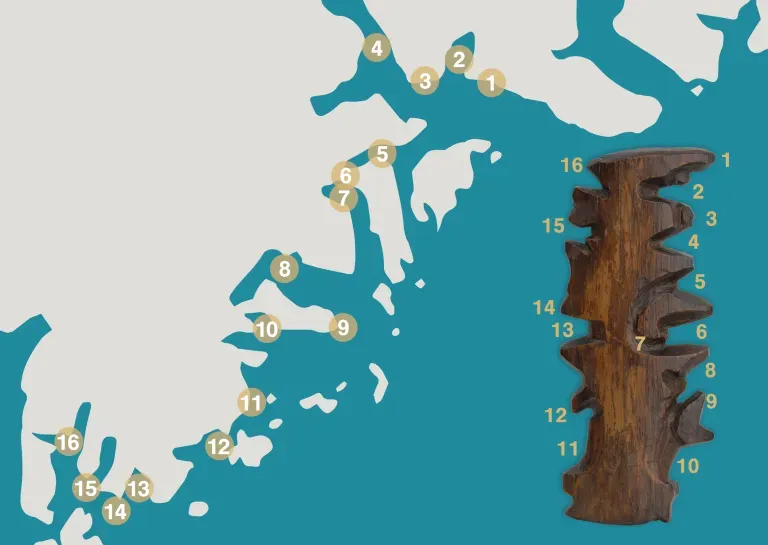
“A century later, the carvings have proven to be remarkable time capsules that capture the perception of the land and sea—alive and with depth—through the eyes of an East Greenlander at the moment of first contact with the Western world. The maps show how the Tunumiit cognitively organized their world, and have captured the imaginations of map enthusiasts around the world for over half a century. But as time passes the maps have acquired a new mythology that doesn’t quite suit them. Anecdotal descriptions of the maps online today compare them to some sort of archaic, ruggedized handheld GPS device: waterproof, small enough to fit inside a mitten, and naturally buoyant. It’s easy to picture a lonely seal hunter in his kayak using the map to navigate through an archipelago by the light of the moon. But this is how we use modern maps, as roadside companions, and suggesting that the Tunumiit used them the same way is nearly as Eurocentric as Hansen-Blangsted’s dismissal. There is, in fact, no ethnographic or historical evidence that carved wooden maps were ever used by any Inuit peoples for navigation in open water, and there are no other similar wooden maps like these found in any collection of Inuit material anywhere else in the world.
“But woodcarving was a common activity among the Tunumiit and Holm mentions that carving maps was not out of the ordinary. The Inuit people have used carvings in a certain way—to accompany stories and illustrate important information about people, places, and things. A wooden relief map, would have functioned as a storytelling device, like a drawing in the sand or snow, that could be discarded after the story was told. As geographer Robert Rundstum has noted, in Inuit tradition, the act of making a map was frequently much more important than the finished map itself. The real map always exists in one’s head. Though the maps themselves are unique, the sentiments and view of the world they represent were universal to the culture that made them.”
Read more: Greenland’s Hand-Sized Wooden Maps Were Used for Storytelling, Not Navigation
War Queens
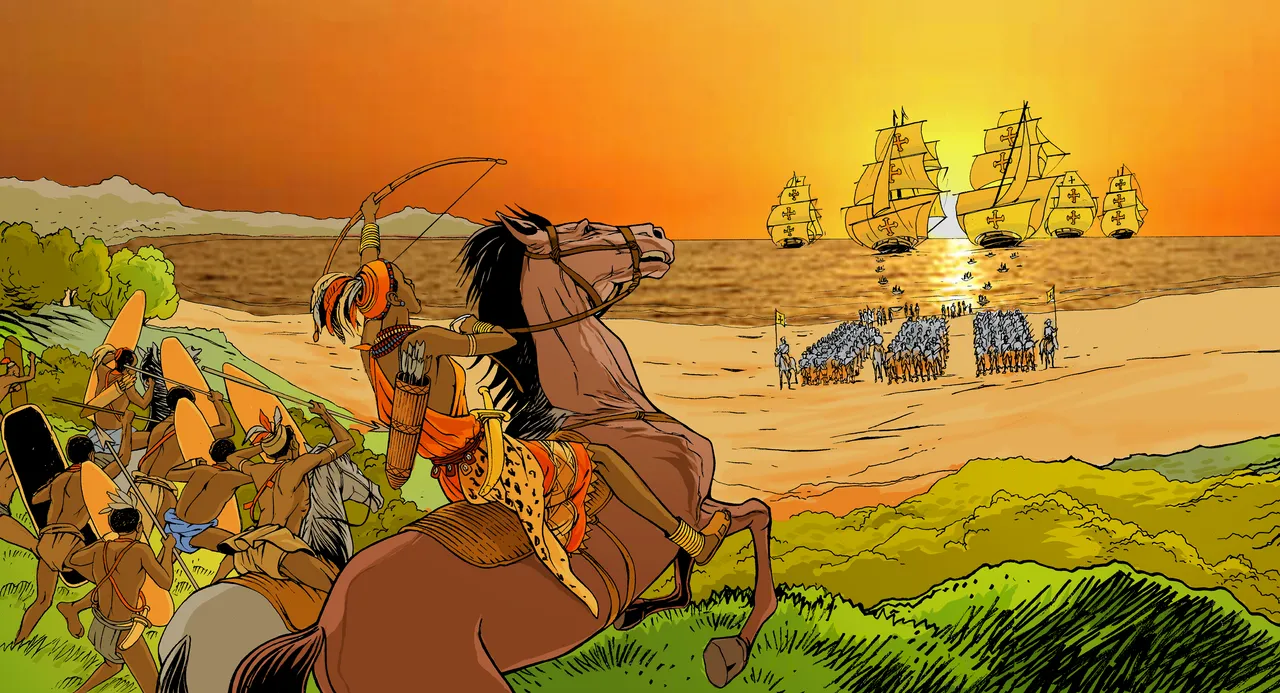
“Horses neighed and fires crackled as Queen Tamar of Georgia walked among her troops on the eve of battle in July 1203. Her enemies outnumbered her soldiers nearly two to one. Still, the queen did not waver as she spoke words of courage to the assembled army. In a show of humility, she stood before them barefoot while wearing lavish garments full of religious symbolism to inspire a righteous bravery in all who saw her. As she finished her rousing speech, hardy, battle-worn soldiers stood, raised their spears, and shouted, ‘To our king!’ The next day, the Georgian army decimated their foe.
“In the late 12th and early 13th centuries, Tamar the Great ushered in Georgia’s golden age. She expanded borders, oversaw massive architectural projects, and helped define the kingdom’s unique identity at the crossroads of East and West. She sat on war councils and, as one chronicler wrote, ‘took counsel with them, not like a helpless person, or a woman, and did not neglect the dictates of reason.’”
Read more: Meet Caterina Sforza and Other Warrior Queens History Forgot
Soft Places, Deep Wells
“We live cheek by jowel with undiscovered worlds. Sometimes the barriers that separate us are thick, sometimes they’re thin, and sometimes they’re breached. That’s when a wardrobe turns into a portal to Narnia, a rabbit hole leads to Wonderland, and a Raquel Welch poster is all that separates a prison cell from the tunnel to freedom.
“Those are all fictional examples. But in 1963, that barrier was breached for real. Taking a sledgehammer to a wall in his basement, a man in the Turkish town of Derinkuyu got more home improvement than he bargained for. Behind the wall, he found a tunnel. And that led to more tunnels, eventually connecting a multitude of halls and chambers. It was a huge underground complex, abandoned by its inhabitants and undiscovered until that fateful swing of the hammer.”
Read more: The Mysterious Underground City Found in a Man’s Basement
The Trees are Staring Back

“After a long, fruitful day of investigating a fascinating pocket of nature, I was looking for a spot to spend the night. The trees, flowers, and mosses confirmed what I had started to suspect: The ground was too damp for a comfortable night. My shoulders sagged a touch as I conceded to myself that I would need to move on to a drier spot. This was a little disappointing near the end of a long day outdoors, so I sat on an old stump for a snack to summon the energy for a push up into the nearby hills. While I was eating some dried fruit, I stared, only partially in focus, at a wall of mixed trees in front of me. After about a quarter of an hour of not thinking of or looking for very much, I noticed the trees staring back at me.“After the energy from my snack had reached my brain, I realized what was going on. I suddenly appreciated what I was looking at and it was something I’d never taken the time to think about before.”And then a minor observation blossomed into a small epiphany. A new natural navigation clue seized me. Seconds later I had more energy than I needed. I could have run in circles with excitement. Instead, I paced frenetically around every tree in the area.”
“The conventional view, as described in a recent National Academy of Sciences report, is that “a harem, also known as a band, consists of a dominant stallion, subordinate adult males and females, and offspring.” At first glance, this assessment would seem to be true: what people notice when watching wild horses is the uproar created by the stallions. But research by Jason Ransom of Colorado State University and others has shown that this male-centric view is wrong. Far from being subordinate, mares frequently initiate the band’s activities. The stallions are quite often little more than hangers-on.
“Ransom was once watching a band of mares that stopped grazing and began heading for water. The stallion didn’t notice. When he looked up and saw his female companions leaving, he panicked. “He started running after them,” Ransom told me. “He was like a little boy calling out, ‘Hey, where’s everybody going?’” The mares ignored him. Whether the stallion caught up or not didn’t appear to concern them.”
Read more:

- “Writing a novel—actually picking the words and filling in paragraphs—is a tremendous pain in the ass. Now that TV’s so good and the Internet is an endless forest of distraction, it’s damn near impossible. That should be taken into account when ranking the all-time greats. Somebody like Charles Dickens, for example, who had nothing better to do except eat mutton and attend public hangings, should get very little credit.” (Source unknown.)
- Readers not unsubscribing is probably the most important metric for any newsletter. Even if they don’t actually read what you’ve written, they haven’t given up on the possibility that they might read the next thing you send them!


